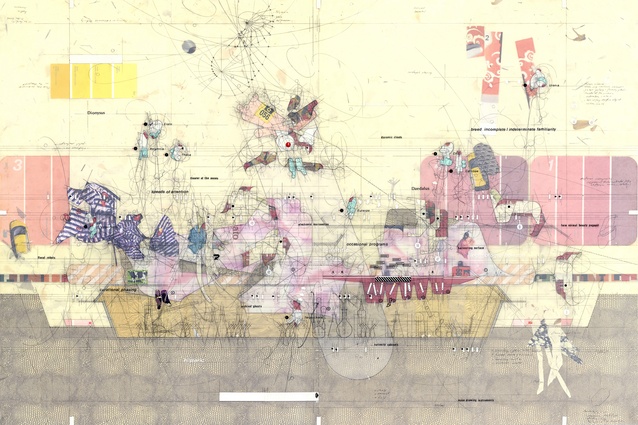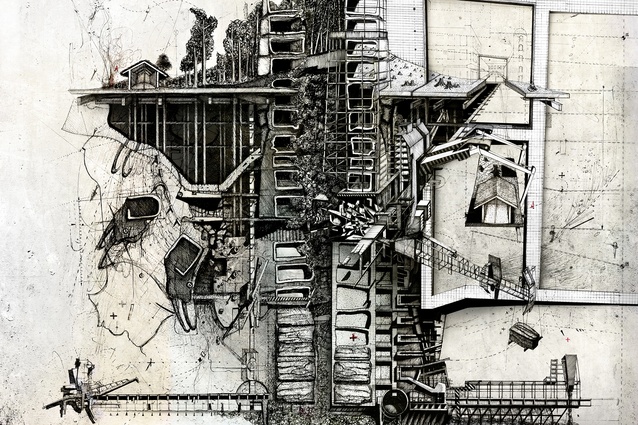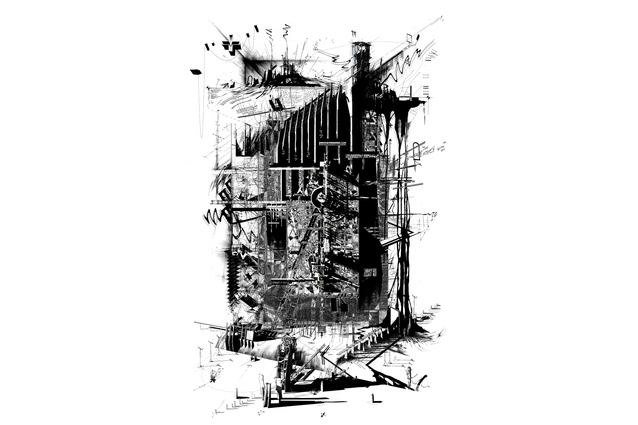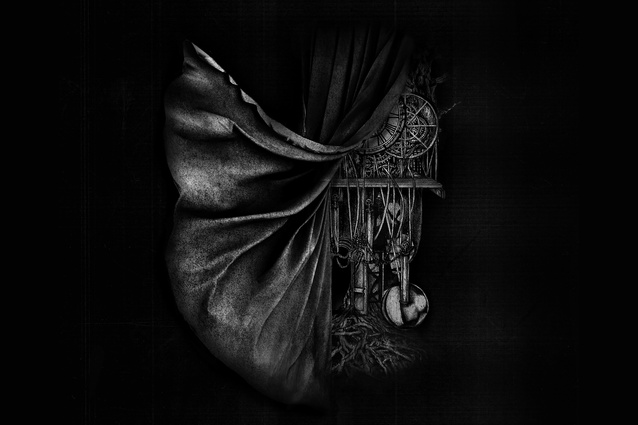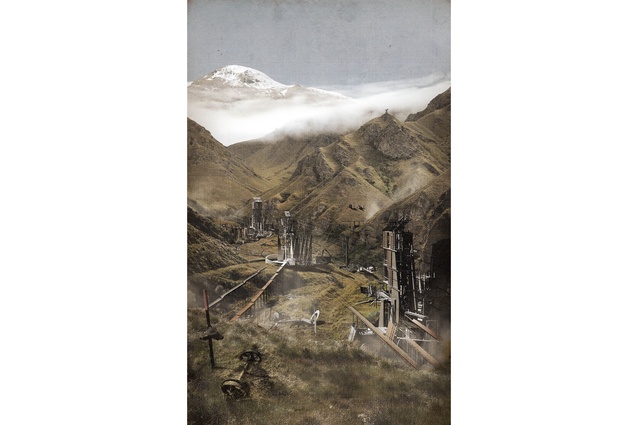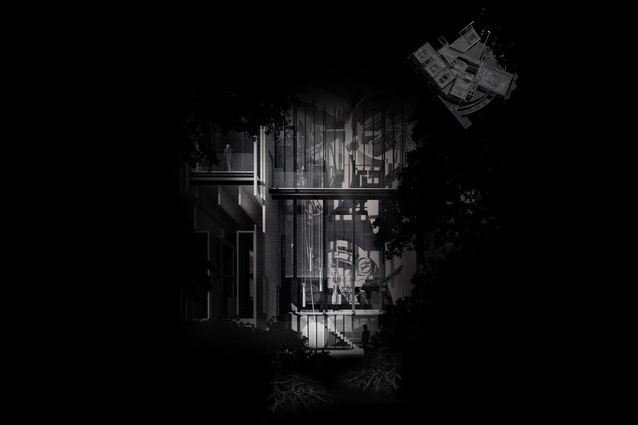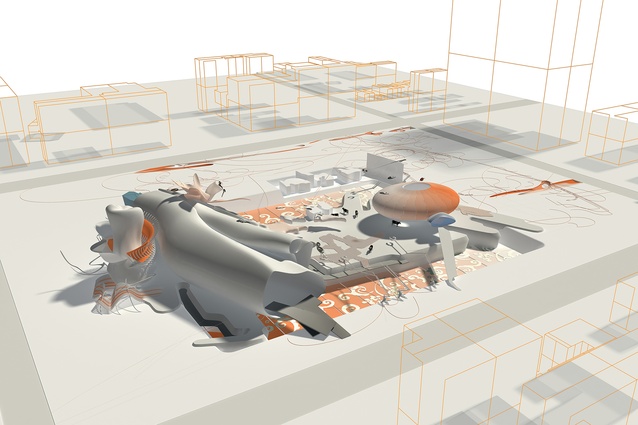Idea-building
Daniel K Brown reflects on the ways in which abstract, speculative architectural drawings can play an important role in contemporary professional practice.
As speculative architectural drawings approach greater levels of abstraction, the question arises as to how (or even if) they might actually contribute to the professional practice of ‘buildable’ architecture. In this article, I reflect on this important contemporary issue by looking at one of Perry Kulper’s speculative drawings for the 2000 Central California History Museum competition (CCHMC), as well as speculative architectural drawings by postgraduates in my ‘Narrative Architecture’ master’s thesis stream at Wellington School of Architecture, Te Herenga Waka – Victoria University of Wellington (VUW).
Because architects today use both analogue and digital tools, the methods of – and opportunities offered by – architectural representation have radically transformed. Analogue design tools and digital design tools play different roles in architectural representation, and ‘hybrid’ analogue/ digital drawings enable these blended tools to address contemporary issues in new ways. Traditionally, ‘presentation drawings’ have been used by architects to convey their ideas to clients, while ‘construction drawings’ have been used to convey the architect’s ideas to builders and suppliers. But these types of architectural representation ‘freeze’ our perception of the architectural intervention in a similar manner to that of a photograph or a painting. Speculative architectural drawings, on the other hand, use hybrid tools to map an architect’s ideas while they are still formulating.

Drawing theorist and architect Brian Edwards argues that, with speculative drawings, “architecture has been liberated from the straightjacket of the orthogonal thought process of plan, section and elevation”.1 Speculative architectural drawings provide the architect with a method of generative representation that reveals new creative opportunities, through the ability to merge social, contextual, cultural and even mythological references with personal experience and intuition.
Perry Kulper
Perry Kulper is an architect and Associate Professor at the University of Michigan’s Taubman College of Architecture and Urban Planning. These dual credentials situate Kulper in the realms of both professional practice and speculative architectural theory. Figure 01 is a ‘proto-formal longitudinal section’ by Kulper for the CCHMC in Fresno, California. According to Kulper, the speculative hybrid drawings that he created for the competition represent “the metaphorical potential of varied mythological accounts (linked to the cultural roots of museums and to the agricultural region where Fresno is located), including Dionysus, the god of wine, fertility and agriculture, Dædalus (the ‘inventor’ of architecture, sculpture and the labyrinth) and the rhetorical potential of the nine Greek muses. … In their respective ways and at different phases of development of the project, … the drawings establish the primary topics and actionable ideas for the museum and consequently, … the scope of the project”.2
Kulper argues that a hybrid, speculative drawing “challenges the additive, or accretive practices of the architect”,3 thereby enabling the creation of conceptual frameworks. With this hybrid digital/analogue design approach, “turning layers on and off – offered generative spatial and representational potential; the agency of file sizes, degrees of resolution and scaling opportunities opened things up; and discovering ideas rather than proving them came front and center”.4
At first glance, Figure 01 might appear to offer little if any contribution to ‘buildable’ architectural practice; Kulper himself acknowledges that his drawings are often ‘cryptic’. But the word ‘cryptic’ implies that one must look deeply into a drawing to decipher its intentions; it alludes to a type of ‘mystery’ that an architect can be expected to solve. Architects share a discipline-specific ‘language’ of notation devices that allows them to decipher ideas through architectural drawing. Kulper’s drawings are replete with this language. According to Kulper, Figure 01 “foregrounds the key aspects, or characteristics, of the main galleries, a primary archive and a theatre of the muses for the museum proposal. Using proto-formal spatial elements, language and representational fragments, it augments the synthetic resolution of perspective construction, using key attributes of the architecture in anticipation of the larger whole.”5 But can such drawings ultimately lead an architect to a ‘buildable form’?
VUW Postgraduate Students
Figures 02–04 represent speculative architectural drawings6 by three architectural designers who recently completed their postgraduate degrees at Wellington School of Architecture. At first glance, these images might appear to offer little if any contribution to ‘buildable’ architectural practice. Jonathan Morrish’s hybrid speculative architectural drawing Tūrangawaewae | A Place to Stand (see Fig. 02) draws from literary fiction, fine art and pūrākau (oral narratives) in his search for architecture’s ‘soul’. Morrish uses Philip Pullman’s fantasy trilogy His Dark Materials as a generative ‘provocateur’ for speculative architectural design. In Pullman’s novels, each character has a ‘dæmon’ – a visible manifestation of their soul who travels alongside them. Through hybrid speculative drawings, Morrish interrogates architecture’s dæmon, its soul, that engenders deeper meaning behind its façade. In Figure 02, a double rākau whakapapa (Māori orator’s mnemonic staff) stands vigil. It takes on the role of a sentinel chronicling the heritage and the identity of tangata whenua – observing, protecting, remembering. Composed of architectural notation marks, grid marks, structural references, implied time lines and multiple orientations and scales, the rākau whakapapa bears witness to the future in one direction and to the past in the other.

William du Toit’s hybrid speculative drawing The Machine Stops: The Stamper Battery (see Fig. 03) draws from E M Forster’s short story ‘The Machine Stops’ as a generative ‘provocateur’ for architectural design. In Forster’s tale, society relies on technology to provide for all its needs and, when the machine breaks down, civilisation collapses. Du Toit uses Forster’s story to generate a tale about heritage and place identity in New Zealand’s rural province of Otago, which was virtually uninhabited until hundreds of stamper batteries – now rusting in the wilderness – were imported into the region to crush stone during the 1860 gold rush. Figure 03 represents this tale from the point of view of the stamper battery. As a narrative speculative drawing, its intention is to reawaken and safeguard this tale of environmental devastation so that we may learn from it in the future. As a speculative hybrid drawing, it combines digital modelling with hand drawing, conveying the stamper battery’s tale through architectural notation devices, grid marks, structural references, implied time lines, and changing orientations and scales.
Alice Charles’ speculative drawing Unveiling an Artefact of Time (see Fig. 04) draws from two related works of literary fiction – Italo Calvino’s novel Invisible Cities and Alan Lightman’s novel Einstein’s Dreams – to reawaken and unveil lost voices of place and time that are visible in our urban landscapes only as scattered fragments. Calvino’s Invisible Cities presents 55 fragmented stories of place, each tale reinterpreting the same place (Venice) from an alternative point of view. Lightman’s Einstein’s Dreams presents 30 fragmented stories of time, each tale reinterpreting time from an alternative point of view. Charles uses these two novels as a framework upon which to re-present the fragmented tales of two Wellington harbourside sites – the Te Papa wharf cut-out and the Kumutoto Stream outlet – that evolved through layers of transformation from one time period to the next. In Figure 04, fragments of time and place move in and out of the half-light beneath the veil. Fragments of place slowly evolve; fragments of
time continually realign. Hidden traces of the natural environment re-emerge. The veil moves softly, concealing and revealing, connecting and disconnecting. Stories of place identity appear, only to disappear once more. This hybrid speculative drawing conveys its tale through architectural references to: grids, thresholds and structural systems; interior artefacts at multiple scales; implied time lines and walkways; and the implications of spatial boundaries.
Professional Practice
All four drawings described above reflect the ways in which hybrid speculative architectural drawings can contribute to idea-building; how such drawings might also inspire forms for buildable architecture is an important question for professional practice. Figure 05 shows Morrish’s design for an apartment building on Taranaki Street in Wellington that arose from his hybrid drawings (see Fig. 02). The design of Morrish’s apartment building has clear references – formally, conceptually, experientially and mythologically – to his speculative architectural drawing. Metaphorically, the plan represents a cyclical procession – sleeping, bathing, eating and communal gathering – that ritually protects and embraces the heritage ruins of Te Aro Pā below.
Figure 06 represents du Toit’s ‘buildable’ design for a multi-unit DOC bunkhouse that was derived from his speculative hybrid drawings (see Fig. 03). This ‘buildable’ translation continues to implicate conceptualisations arising from Figure 03, spatially, formally and mythologically. Experiential rituals of daily life are related to the primordial elements of nature and related construction materials: crossing a threshold (earth/stone), sharing a meal (fire/timber), sleeping (air/glass) and cleansing (water/stainless steel). Over time, each material will decay at a different rate from that of the others, thereby showcasing the dialectic confrontation of environmental versus man-made systems. Figure 07 represents Charles’ developed design for a timekeeper’s sanctuary. Translating conceptualisations that arose from her hybrid drawings (see Fig. 04), the ‘buildable’ version continues to evidence references to: grids, thresholds and structural systems; interior artefacts at multiple scales; implied time lines and walkways; and the implications of spatial boundaries.
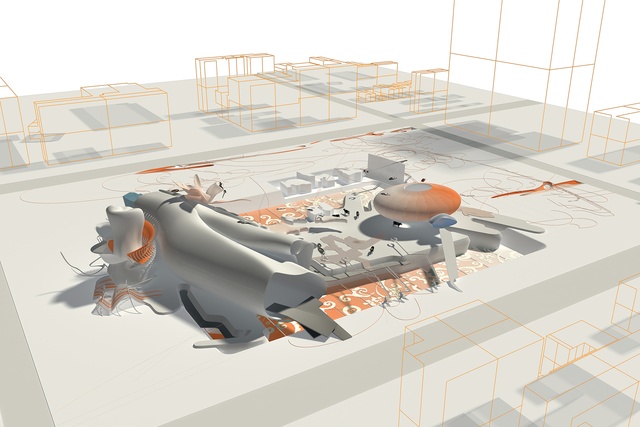
Figure 08 suggests ways in which Kulper’s speculative drawings for the CCHMC (see Fig. 01) might be translated into buildable form. It is interesting to note that, even now, Kulper continues to develop and build speculative ideas arising from his ‘cryptic’ drawings for the 2000 CCHMC, and he reflects that Figure 08 is only “a very first, sketch, and, if I worked properly on it, the proposal would likely not look much like it does”.7 Hybrid, speculative architectural drawings are not meant to lead to one ‘buildable’ form; they are idea-generating, rather than form-building. Kulper maintains that: “Unlike most conventional architectural drawings, which instrumentally describe organizational and geometric properties of a project, [speculative] drawings have no particular geographic, scalar and geometric orientation.
They establish relational assemblies, or contours of relations en route to specific geometric, material, scalar and durational design choices. … This way of working emerged as a way to circumvent a ‘crisis of representational reduction,’ lodged in many traditional architectural drawings.”8
While hybrid speculative architectural drawings may appear ‘cryptic’, they build upon a notational language understandable to architects and, as such, they can enable architects in professional practice to assemble, record and communicate ongoing generative ideas through architectural drawing. As hybrid representations, they have the capacity to provide a rich and vibrant foundation for contemporary professional practice that can lead to unexpected new conceptualisations for ‘buildable’ architectural forms.
1 Brian Edwards, Understanding Architecture through Drawing (2nd ed.), Taylor & Francis, 2008. p. 233.
2 Perry Kulper, Manual drawings, Issuu, October 7, 2017, p. 21. issuu.com/perrykulper/docs/pkulper.
3 Perry Kulper, Manual drawings, Issuu, October 7, 2017, p. 28. issuu.com/perrykulper/docs/pkulper.
4 Perry Kulper, ‘Avant-garde legacies: A spirited flâneur’, Architectural Design, 89 (4), 2019, p. 65.
5 Perry Kulper, ‘A world below’, Architectural Design: Drawing Architecture, 83 (5), 2013, p. 60.
6 These drawings are currently in an exhibition of speculative architectural drawings, curated by Daniel K Brown, at the Adam Art Gallery in Wellington, 20 November 2021 – 27 March 2022 (closed 18 December 2021 – 17 January 2022).
7 Perry Kulper, email to Daniel K Brown, 18 November 2021.
8 Perry Kulper, Manual drawings, Issuu, October 7, 2017, p. 21. issuu.com/perrykulper/docs/pkulper.

